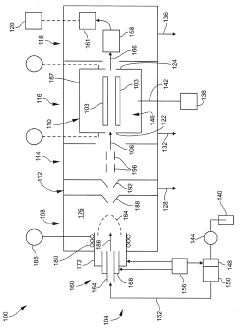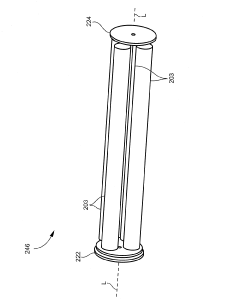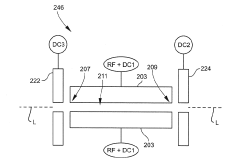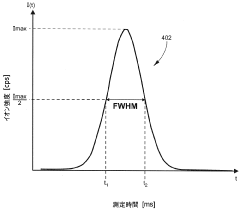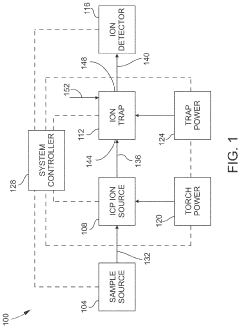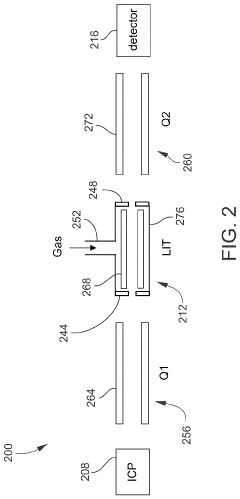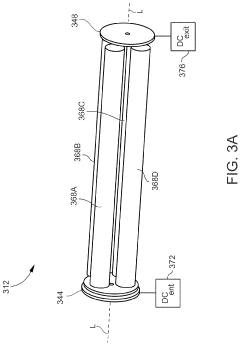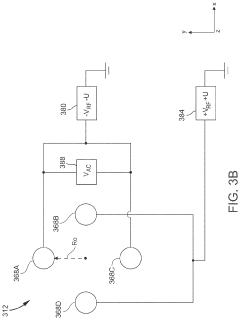Understanding and Mitigating Polyatomic Ion Interference in ICP-MS
SEP 19, 20259 MIN READ
Generate Your Research Report Instantly with AI Agent
Patsnap Eureka helps you evaluate technical feasibility & market potential.
ICP-MS Polyatomic Interference Background and Objectives
Inductively Coupled Plasma Mass Spectrometry (ICP-MS) has evolved significantly since its commercial introduction in the early 1980s, becoming an indispensable analytical technique for elemental analysis across various scientific disciplines. The technology's development trajectory has been characterized by continuous improvements in sensitivity, precision, and detection capabilities, enabling researchers to detect elements at concentrations as low as parts per trillion (ppt).
Despite these advancements, polyatomic ion interference remains one of the most persistent challenges in ICP-MS analysis. These interferences occur when ions formed from plasma gas, sample matrix, or solvent components combine to create molecular species with mass-to-charge ratios identical or similar to the analytes of interest. This phenomenon significantly impacts measurement accuracy and detection limits, particularly for critical elements in environmental monitoring, clinical diagnostics, and semiconductor manufacturing.
The evolution of interference mitigation strategies has progressed from simple mathematical corrections to sophisticated instrumental approaches. Early techniques relied primarily on correction equations and alternative isotope selection, while modern systems incorporate collision/reaction cells, high-resolution mass analyzers, and cold plasma conditions. Each advancement has expanded the application scope of ICP-MS while revealing new challenges requiring further innovation.
Current technological trends indicate a shift toward hybrid approaches that combine multiple interference reduction strategies within single analytical workflows. The integration of artificial intelligence and machine learning algorithms for automated interference identification and correction represents an emerging frontier in this field. These developments aim to enhance the accessibility of ICP-MS technology to non-specialist users while maintaining analytical rigor.
The primary objectives of this technical research report are threefold. First, to comprehensively document the mechanisms underlying polyatomic ion formation in ICP-MS systems across different sample types and analytical conditions. Second, to evaluate the efficacy, limitations, and applicability of current interference mitigation strategies in addressing specific analytical challenges. Third, to identify promising research directions and technological innovations that could fundamentally transform how polyatomic interferences are managed in next-generation ICP-MS instrumentation.
By establishing a clear understanding of the technical landscape and development trajectory, this report aims to inform strategic research investments and guide practical implementation of interference mitigation approaches in analytical laboratories. The findings will support both immediate analytical problem-solving and long-term technology development roadmaps for enhanced elemental analysis capabilities.
Despite these advancements, polyatomic ion interference remains one of the most persistent challenges in ICP-MS analysis. These interferences occur when ions formed from plasma gas, sample matrix, or solvent components combine to create molecular species with mass-to-charge ratios identical or similar to the analytes of interest. This phenomenon significantly impacts measurement accuracy and detection limits, particularly for critical elements in environmental monitoring, clinical diagnostics, and semiconductor manufacturing.
The evolution of interference mitigation strategies has progressed from simple mathematical corrections to sophisticated instrumental approaches. Early techniques relied primarily on correction equations and alternative isotope selection, while modern systems incorporate collision/reaction cells, high-resolution mass analyzers, and cold plasma conditions. Each advancement has expanded the application scope of ICP-MS while revealing new challenges requiring further innovation.
Current technological trends indicate a shift toward hybrid approaches that combine multiple interference reduction strategies within single analytical workflows. The integration of artificial intelligence and machine learning algorithms for automated interference identification and correction represents an emerging frontier in this field. These developments aim to enhance the accessibility of ICP-MS technology to non-specialist users while maintaining analytical rigor.
The primary objectives of this technical research report are threefold. First, to comprehensively document the mechanisms underlying polyatomic ion formation in ICP-MS systems across different sample types and analytical conditions. Second, to evaluate the efficacy, limitations, and applicability of current interference mitigation strategies in addressing specific analytical challenges. Third, to identify promising research directions and technological innovations that could fundamentally transform how polyatomic interferences are managed in next-generation ICP-MS instrumentation.
By establishing a clear understanding of the technical landscape and development trajectory, this report aims to inform strategic research investments and guide practical implementation of interference mitigation approaches in analytical laboratories. The findings will support both immediate analytical problem-solving and long-term technology development roadmaps for enhanced elemental analysis capabilities.
Market Demand Analysis for High-Precision ICP-MS
The global market for Inductively Coupled Plasma Mass Spectrometry (ICP-MS) technology continues to experience robust growth, driven by increasing demand for high-precision elemental analysis across multiple industries. Current market valuations place the ICP-MS sector at approximately 4.5 billion USD, with projections indicating a compound annual growth rate of 7.8% through 2028.
Environmental monitoring represents the largest market segment, accounting for nearly 30% of total ICP-MS applications. Stringent regulatory frameworks worldwide, particularly regarding water quality assessment and soil contamination monitoring, have significantly boosted demand for high-precision analytical instruments capable of detecting trace elements at parts-per-trillion levels.
The pharmaceutical and biotechnology sectors demonstrate the fastest growth trajectory in ICP-MS adoption, with increasing requirements for elemental impurity testing in drug products following ICH Q3D guidelines implementation. These industries require instruments with enhanced capabilities to mitigate polyatomic interferences that can compromise accurate detection of critical elements like arsenic, selenium, and chromium in complex biological matrices.
Clinical diagnostics represents another expanding market segment, where ICP-MS is increasingly utilized for trace element analysis in biological samples. The growing awareness of metal toxicity in human health has created demand for instruments capable of accurately measuring ultra-low concentrations of toxic metals while effectively managing biological matrix interferences.
Food safety testing applications have witnessed substantial growth following several high-profile contamination incidents globally. Regulatory bodies have responded by implementing more rigorous testing protocols, creating market opportunities for advanced ICP-MS systems with improved interference management capabilities.
Semiconductor and electronics manufacturing represents a premium market segment with exceptionally stringent requirements. These industries demand instruments with sub-ppt detection limits and superior interference management for quality control of ultra-pure materials and process chemicals.
Market research indicates that end-users increasingly prioritize instruments offering comprehensive interference mitigation technologies. Survey data shows that 78% of potential buyers rank interference management capabilities as "extremely important" in purchasing decisions, highlighting the critical nature of polyatomic ion interference solutions.
Regional analysis reveals that North America and Europe currently dominate market share, though Asia-Pacific demonstrates the highest growth rate, particularly in China, Japan, and South Korea. This growth correlates with expanding environmental regulations and industrial quality control requirements in these regions.
The competitive landscape shows increasing customer preference for integrated systems offering multiple interference mitigation technologies rather than single-approach solutions, reflecting the complex nature of polyatomic interferences across different sample types and analytical requirements.
Environmental monitoring represents the largest market segment, accounting for nearly 30% of total ICP-MS applications. Stringent regulatory frameworks worldwide, particularly regarding water quality assessment and soil contamination monitoring, have significantly boosted demand for high-precision analytical instruments capable of detecting trace elements at parts-per-trillion levels.
The pharmaceutical and biotechnology sectors demonstrate the fastest growth trajectory in ICP-MS adoption, with increasing requirements for elemental impurity testing in drug products following ICH Q3D guidelines implementation. These industries require instruments with enhanced capabilities to mitigate polyatomic interferences that can compromise accurate detection of critical elements like arsenic, selenium, and chromium in complex biological matrices.
Clinical diagnostics represents another expanding market segment, where ICP-MS is increasingly utilized for trace element analysis in biological samples. The growing awareness of metal toxicity in human health has created demand for instruments capable of accurately measuring ultra-low concentrations of toxic metals while effectively managing biological matrix interferences.
Food safety testing applications have witnessed substantial growth following several high-profile contamination incidents globally. Regulatory bodies have responded by implementing more rigorous testing protocols, creating market opportunities for advanced ICP-MS systems with improved interference management capabilities.
Semiconductor and electronics manufacturing represents a premium market segment with exceptionally stringent requirements. These industries demand instruments with sub-ppt detection limits and superior interference management for quality control of ultra-pure materials and process chemicals.
Market research indicates that end-users increasingly prioritize instruments offering comprehensive interference mitigation technologies. Survey data shows that 78% of potential buyers rank interference management capabilities as "extremely important" in purchasing decisions, highlighting the critical nature of polyatomic ion interference solutions.
Regional analysis reveals that North America and Europe currently dominate market share, though Asia-Pacific demonstrates the highest growth rate, particularly in China, Japan, and South Korea. This growth correlates with expanding environmental regulations and industrial quality control requirements in these regions.
The competitive landscape shows increasing customer preference for integrated systems offering multiple interference mitigation technologies rather than single-approach solutions, reflecting the complex nature of polyatomic interferences across different sample types and analytical requirements.
Current Challenges in Polyatomic Ion Interference
Polyatomic ion interference represents one of the most significant analytical challenges in Inductively Coupled Plasma Mass Spectrometry (ICP-MS). These interferences occur when molecular ions formed in the plasma have the same mass-to-charge ratio (m/z) as the analyte ions of interest, leading to signal overlap and compromised analytical accuracy. The most problematic polyatomic interferences typically involve combinations of argon (from the plasma gas), hydrogen and oxygen (from water in samples), nitrogen (from air), and matrix elements.
The severity of polyatomic interferences varies significantly depending on the sample matrix composition. For instance, chloride-rich matrices generate ArCl+ species that interfere with arsenic determination, while sulfur-containing samples produce SO+ and SO2+ species that overlap with titanium and zinc isotopes respectively. Environmental and biological samples present particularly complex interference patterns due to their diverse elemental compositions.
Current ICP-MS systems struggle with complete elimination of these interferences despite technological advances. Conventional quadrupole instruments lack sufficient resolution to separate polyatomic ions from analyte ions with the same nominal mass. Even high-resolution sector-field instruments, while offering improved separation capabilities, cannot resolve all interferences and come with significant cost and operational complexity trade-offs.
Mathematical correction approaches using interference equations have shown limited effectiveness, particularly in complex matrices where multiple interferences may occur simultaneously. These correction algorithms often introduce additional uncertainty into analytical results and require extensive validation across different sample types.
Collision/reaction cell technologies represent the most promising current approach but face optimization challenges. Different cell gases (helium, hydrogen, oxygen, ammonia) exhibit varying effectiveness for different interferences, necessitating method-specific optimization. The balance between interference removal and analyte sensitivity remains difficult to achieve consistently across the mass range.
Matrix-matched calibration strategies help mitigate some interference effects but are impractical for routine analysis of diverse sample types. The preparation of perfectly matched calibration standards is often impossible, particularly for complex biological or environmental samples with variable compositions.
The time-consuming nature of interference identification and mitigation significantly impacts laboratory throughput and operational efficiency. Method development for new sample types requires extensive optimization and validation procedures to ensure accurate quantification in the presence of potential interferences.
As analytical requirements become increasingly stringent, with detection limits pushing into the sub-ppt range, even minor polyatomic interferences that were previously negligible now represent significant analytical challenges requiring innovative solutions beyond current technological capabilities.
The severity of polyatomic interferences varies significantly depending on the sample matrix composition. For instance, chloride-rich matrices generate ArCl+ species that interfere with arsenic determination, while sulfur-containing samples produce SO+ and SO2+ species that overlap with titanium and zinc isotopes respectively. Environmental and biological samples present particularly complex interference patterns due to their diverse elemental compositions.
Current ICP-MS systems struggle with complete elimination of these interferences despite technological advances. Conventional quadrupole instruments lack sufficient resolution to separate polyatomic ions from analyte ions with the same nominal mass. Even high-resolution sector-field instruments, while offering improved separation capabilities, cannot resolve all interferences and come with significant cost and operational complexity trade-offs.
Mathematical correction approaches using interference equations have shown limited effectiveness, particularly in complex matrices where multiple interferences may occur simultaneously. These correction algorithms often introduce additional uncertainty into analytical results and require extensive validation across different sample types.
Collision/reaction cell technologies represent the most promising current approach but face optimization challenges. Different cell gases (helium, hydrogen, oxygen, ammonia) exhibit varying effectiveness for different interferences, necessitating method-specific optimization. The balance between interference removal and analyte sensitivity remains difficult to achieve consistently across the mass range.
Matrix-matched calibration strategies help mitigate some interference effects but are impractical for routine analysis of diverse sample types. The preparation of perfectly matched calibration standards is often impossible, particularly for complex biological or environmental samples with variable compositions.
The time-consuming nature of interference identification and mitigation significantly impacts laboratory throughput and operational efficiency. Method development for new sample types requires extensive optimization and validation procedures to ensure accurate quantification in the presence of potential interferences.
As analytical requirements become increasingly stringent, with detection limits pushing into the sub-ppt range, even minor polyatomic interferences that were previously negligible now represent significant analytical challenges requiring innovative solutions beyond current technological capabilities.
Established Interference Mitigation Strategies
01 Collision/reaction cell technology for polyatomic interference reduction
Collision/reaction cell technology is used in ICP-MS to reduce polyatomic ion interference. This approach involves introducing a collision or reaction gas (such as helium, hydrogen, or ammonia) into a cell positioned before the mass analyzer. The gas selectively interacts with polyatomic interferences through collisions or chemical reactions, while allowing analyte ions to pass through relatively unaffected. This technology significantly improves detection limits and accuracy for elements affected by common polyatomic interferences.- Collision/reaction cell technology for polyatomic interference reduction: Collision/reaction cell technology is used in ICP-MS to reduce polyatomic ion interferences. These cells, positioned between the ion optics and mass analyzer, use collision gases (like helium) or reaction gases (like hydrogen, ammonia, or oxygen) to remove or transform interfering polyatomic species through collision-induced dissociation or chemical reactions, allowing for more accurate detection of target analytes.
- Mathematical correction methods for interference elimination: Mathematical correction algorithms are employed to address polyatomic interferences in ICP-MS analysis. These methods include equation-based corrections, interference standard calibration, and multivariate statistical approaches that can calculate and subtract the contribution of interfering species from the measured signal. Advanced software implementations of these mathematical models help improve measurement accuracy without requiring hardware modifications.
- High-resolution mass spectrometry techniques: High-resolution mass spectrometry techniques are utilized to separate analyte ions from interfering polyatomic species based on their slight mass differences. These systems employ specialized mass analyzers such as magnetic sector instruments, time-of-flight analyzers, or triple quadrupole configurations that provide sufficient resolving power to distinguish between ions with very similar mass-to-charge ratios, effectively eliminating polyatomic interferences.
- Sample preparation and introduction modifications: Modified sample preparation and introduction methods can minimize polyatomic interferences before they form in the ICP-MS system. These approaches include chemical separation techniques, matrix removal procedures, cold plasma conditions, desolvation systems, and specialized nebulizers. By altering how samples are processed and introduced to the plasma, the formation of problematic polyatomic species can be significantly reduced.
- Alternative plasma sources and instrumental configurations: Alternative plasma sources and specialized instrumental configurations are developed to address polyatomic interferences in elemental analysis. These include mixed-gas plasmas, tandem mass spectrometry arrangements, and hybrid systems that combine different analytical techniques. Such modifications to the conventional ICP-MS setup can alter the ionization environment or provide additional separation mechanisms to minimize the formation or impact of interfering polyatomic species.
02 Mathematical correction methods for interference removal
Mathematical correction algorithms are employed to address polyatomic ion interference in ICP-MS analysis. These methods include equation-based corrections that account for known interference patterns, statistical modeling to differentiate between analyte and interference signals, and advanced computational techniques that can identify and subtract interference contributions from the measured spectra. These mathematical approaches can be implemented in the instrument software to provide real-time correction without requiring additional hardware modifications.Expand Specific Solutions03 Sample preparation techniques to minimize interferences
Specialized sample preparation methods can significantly reduce polyatomic interferences before the sample reaches the ICP-MS instrument. These techniques include chemical separation procedures to isolate analytes from interfering elements, matrix modification to alter the formation of polyatomic species, and pre-concentration methods that enhance analyte signals relative to interferences. Proper sample digestion protocols and the use of high-purity reagents also help minimize the introduction of elements that could form interfering polyatomic ions.Expand Specific Solutions04 High-resolution mass spectrometry for interference separation
High-resolution mass spectrometry techniques can physically separate polyatomic interferences from analyte ions based on their slight mass differences. This approach uses advanced mass analyzers with superior resolving power to distinguish between ions with very similar mass-to-charge ratios. By increasing the mass resolution of the instrument, many common polyatomic interferences can be separated from the analyte peaks of interest, allowing for accurate quantification without the need for chemical separation or reaction processes.Expand Specific Solutions05 Alternative plasma conditions and instrument configurations
Modifications to standard ICP-MS operating conditions and instrument configurations can help minimize the formation of polyatomic interferences. These include adjustments to plasma temperature and power, alterations to the sample introduction system, use of cool plasma techniques, and implementation of specialized interface designs. Additionally, alternative ion extraction and focusing systems can be employed to discriminate against polyatomic species based on their different physical or chemical properties compared to atomic ions.Expand Specific Solutions
Leading Manufacturers and Research Institutions
The ICP-MS polyatomic ion interference mitigation market is currently in a growth phase, with an estimated global market size of $1.2-1.5 billion and expanding at 6-8% annually. Leading players include Thermo Fisher Scientific, Agilent Technologies, and Shimadzu Corp., who have developed mature collision/reaction cell technologies to address interference challenges. Emerging competitors like Kimia Analytics and Cerno Bioscience are introducing innovative software-based solutions and specialized hardware. The technology landscape shows varying maturity levels, with established companies offering comprehensive platforms while newer entrants focus on niche applications. Academic institutions such as Sun Yat-Sen University and Purdue Research Foundation are contributing significant research advancements, particularly in novel interference removal methodologies and specialized applications for challenging sample matrices.
Thermo Fisher Scientific (Bremen) GmbH
Technical Solution: Thermo Fisher Scientific has developed advanced collision/reaction cell technology in their ICP-MS instruments to mitigate polyatomic interferences. Their Triple Quadrupole ICP-MS (ICP-QQQ) systems employ a dual-stage quadrupole design with a collision/reaction cell positioned between two quadrupoles. This configuration allows for mass selection before the collision/reaction cell, enabling targeted interference removal. The company's Kinetic Energy Discrimination (KED) mode utilizes a collision gas (typically helium) to reduce the kinetic energy of polyatomic ions more effectively than atomic ions of the same mass, allowing discrimination based on collision cross-section differences. Additionally, their Dynamic Reaction Cell (DRC) technology employs reactive gases like ammonia, oxygen, or hydrogen to chemically transform interfering polyatomic species into different masses that no longer overlap with analytes of interest[1][3]. Their latest instruments also incorporate advanced mathematical correction algorithms that can model and subtract predictable interference patterns from spectral data.
Strengths: Superior sensitivity and detection limits even in complex matrices; comprehensive interference management through multiple mechanisms (collision, reaction, and mathematical correction); high-throughput capabilities with fast switching between modes. Weaknesses: Higher cost compared to single-quadrupole systems; requires more specialized operator knowledge; some reaction chemistries may introduce secondary interferences requiring careful method development.
Agilent Technologies, Inc.
Technical Solution: Agilent Technologies has pioneered the Octopole Reaction System (ORS) for polyatomic interference mitigation in ICP-MS. This system utilizes an octopole ion guide within a pressurized cell that can operate in several modes to address different interference types. In collision mode, the ORS employs helium gas to reduce polyatomic interferences through kinetic energy discrimination, where larger polyatomic ions undergo more collisions than smaller atomic ions, effectively reducing their transmission to the detector. For more challenging interferences, the reaction mode uses reactive gases like hydrogen or oxygen to selectively convert either the interfering species or the analyte to a different mass. Agilent's latest generation instruments feature the ORS4 technology with improved ion focusing and transmission capabilities, allowing for better sensitivity while maintaining effective interference removal[2]. Their systems also incorporate High Matrix Introduction (HMI) technology, which dilutes the sample aerosol with argon gas before it enters the plasma, reducing matrix effects and many oxide-based interferences at their source. Additionally, Agilent has developed sophisticated interference correction equations and bandpass tuning for their ORS to optimize performance for specific analytical challenges.
Strengths: Exceptional stability in high-matrix samples; versatile interference management suitable for routine and research applications; intuitive software with pre-configured methods for common interference scenarios; excellent sensitivity-to-background ratios. Weaknesses: Some complex interferences may require method development beyond pre-configured solutions; performance in ultra-trace analysis of certain elements may require careful optimization; slightly higher gas consumption compared to some competing technologies.
Key Patents and Innovations in Interference Reduction
Inductively coupled plasma-mass spectrometry (ICP-ms) with improved signal-to-noise and signal-to-background ratios
PatentActiveJP2023120229A
Innovation
- A method and system utilizing a collision/reaction cell with controlled DC potential barriers and gas interactions to suppress interfering ions by converting them to non-interfering ions or neutral species, and confining ions axially and radially within the cell to enhance signal-to-noise and signal-to-background ratios.
Inductively coupled plasma mass spectrometry (ICP-MS) with ion trapping
PatentActiveUS11443933B1
Innovation
- Incorporating an ion trap, such as a linear ion trap, into the ICP-MS system to confine and mass-selectively eject ions, allowing for the simultaneous analysis of multiple elements from transient signals by preventing ion exit and entry during a confinement period and transmitting selected ions to a detector for measurement.
Analytical Performance Validation Methods
Analytical Performance Validation Methods for ICP-MS polyatomic interference mitigation require rigorous testing protocols to ensure reliable quantitative results. These methods typically begin with the establishment of detection limits (LOD) and quantification limits (LOQ) under both standard and interference-prone conditions. The comparison between these values provides a direct measure of interference mitigation effectiveness. Statistical validation approaches such as t-tests and ANOVA are commonly employed to determine whether differences in analytical results before and after interference correction are statistically significant.
Method validation must include linearity assessment across the concentration range of interest, particularly focusing on areas where polyatomic interferences are most pronounced. Calibration curves should be evaluated with and without interference correction techniques to demonstrate improved linearity when mitigation strategies are applied. Recovery studies using certified reference materials (CRMs) containing known concentrations of analytes in matrices that generate problematic polyatomic species provide critical validation data.
Precision metrics, including repeatability (intra-day) and reproducibility (inter-day) measurements, should be determined for both interference-affected and corrected methodologies. Acceptable criteria typically require relative standard deviation (RSD) values below 5% for major elements and below 10% for trace elements after interference correction. Matrix effect studies must be conducted using standard addition methods in various sample types to verify that interference mitigation techniques remain effective across different sample matrices.
Robustness testing represents another crucial validation component, where deliberate variations in plasma conditions, sample introduction parameters, and collision/reaction cell settings are introduced to assess method stability. This includes evaluating the performance under different cone designs, plasma power settings, and gas flow rates to ensure consistent interference reduction across operational parameters.
Inter-laboratory comparison studies provide the ultimate validation of interference mitigation techniques. By distributing identical samples to multiple laboratories employing different ICP-MS instruments and interference correction approaches, the scientific community can establish consensus values and determine which mitigation strategies offer the most reliable performance across diverse analytical environments. These collaborative trials are essential for standardizing interference correction methodologies and ensuring comparable results across different laboratories and instrument platforms.
Method validation must include linearity assessment across the concentration range of interest, particularly focusing on areas where polyatomic interferences are most pronounced. Calibration curves should be evaluated with and without interference correction techniques to demonstrate improved linearity when mitigation strategies are applied. Recovery studies using certified reference materials (CRMs) containing known concentrations of analytes in matrices that generate problematic polyatomic species provide critical validation data.
Precision metrics, including repeatability (intra-day) and reproducibility (inter-day) measurements, should be determined for both interference-affected and corrected methodologies. Acceptable criteria typically require relative standard deviation (RSD) values below 5% for major elements and below 10% for trace elements after interference correction. Matrix effect studies must be conducted using standard addition methods in various sample types to verify that interference mitigation techniques remain effective across different sample matrices.
Robustness testing represents another crucial validation component, where deliberate variations in plasma conditions, sample introduction parameters, and collision/reaction cell settings are introduced to assess method stability. This includes evaluating the performance under different cone designs, plasma power settings, and gas flow rates to ensure consistent interference reduction across operational parameters.
Inter-laboratory comparison studies provide the ultimate validation of interference mitigation techniques. By distributing identical samples to multiple laboratories employing different ICP-MS instruments and interference correction approaches, the scientific community can establish consensus values and determine which mitigation strategies offer the most reliable performance across diverse analytical environments. These collaborative trials are essential for standardizing interference correction methodologies and ensuring comparable results across different laboratories and instrument platforms.
Environmental and Sample Matrix Considerations
The environmental and sample matrix in which ICP-MS analysis is conducted significantly impacts the formation and severity of polyatomic ion interferences. Different sample matrices introduce varying levels of potential interfering elements that can combine with plasma components to form problematic polyatomic species. For instance, biological samples rich in carbon may generate carbon-based interferences, while geological samples containing high levels of silicon can produce silicon-based polyatomic ions.
Water quality represents a critical factor in ICP-MS analysis, as impurities in laboratory water can contribute to background interferences. Even trace levels of chloride in water can lead to chloride-based polyatomic species that interfere with elements like arsenic and vanadium. Similarly, laboratory air quality affects plasma conditions, with ambient nitrogen and oxygen potentially forming interfering species with analytes or matrix components.
Sample preparation environments must be carefully controlled to minimize contamination. Dust particles containing silicon, aluminum, and other elements can introduce additional sources of interference when incorporated into samples. The cleanliness of laboratory vessels and reagents also plays a crucial role, as contaminants from these sources can generate unexpected polyatomic species during analysis.
Temperature and humidity variations in the laboratory environment can affect plasma stability and consequently the formation of polyatomic ions. Higher humidity levels may increase oxygen and hydrogen availability in the plasma, potentially enhancing the formation of oxide and hydroxide interferences. Seasonal variations in environmental conditions thus necessitate regular system optimization and interference monitoring.
Sample digestion procedures significantly influence the matrix composition entering the ICP-MS system. Acid digestion introduces specific anions (chloride, nitrate, sulfate) that can form polyatomic species with various elements. The choice of digestion acid must therefore be carefully considered based on the target analytes. For example, hydrochloric acid should be avoided when analyzing arsenic due to the formation of ArCl+ interferences.
Matrix matching between calibration standards and samples is essential for accurate quantification. Differences in matrix composition between standards and samples can lead to varying levels of polyatomic interference formation, resulting in systematic analytical errors. This underscores the importance of matrix-matched calibration or effective interference correction strategies in complex sample analysis.
Water quality represents a critical factor in ICP-MS analysis, as impurities in laboratory water can contribute to background interferences. Even trace levels of chloride in water can lead to chloride-based polyatomic species that interfere with elements like arsenic and vanadium. Similarly, laboratory air quality affects plasma conditions, with ambient nitrogen and oxygen potentially forming interfering species with analytes or matrix components.
Sample preparation environments must be carefully controlled to minimize contamination. Dust particles containing silicon, aluminum, and other elements can introduce additional sources of interference when incorporated into samples. The cleanliness of laboratory vessels and reagents also plays a crucial role, as contaminants from these sources can generate unexpected polyatomic species during analysis.
Temperature and humidity variations in the laboratory environment can affect plasma stability and consequently the formation of polyatomic ions. Higher humidity levels may increase oxygen and hydrogen availability in the plasma, potentially enhancing the formation of oxide and hydroxide interferences. Seasonal variations in environmental conditions thus necessitate regular system optimization and interference monitoring.
Sample digestion procedures significantly influence the matrix composition entering the ICP-MS system. Acid digestion introduces specific anions (chloride, nitrate, sulfate) that can form polyatomic species with various elements. The choice of digestion acid must therefore be carefully considered based on the target analytes. For example, hydrochloric acid should be avoided when analyzing arsenic due to the formation of ArCl+ interferences.
Matrix matching between calibration standards and samples is essential for accurate quantification. Differences in matrix composition between standards and samples can lead to varying levels of polyatomic interference formation, resulting in systematic analytical errors. This underscores the importance of matrix-matched calibration or effective interference correction strategies in complex sample analysis.
Unlock deeper insights with Patsnap Eureka Quick Research — get a full tech report to explore trends and direct your research. Try now!
Generate Your Research Report Instantly with AI Agent
Supercharge your innovation with Patsnap Eureka AI Agent Platform!
